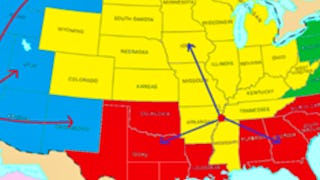Optimization is an important piece of an agile supply chain. In this course, we will explore the components of optimization and how to set up an optimization problem in Excel. We will also practice capacity and resource optimization and explore examples of both in the supply chain. Building off of our optimization practice, we will next learn how to use a Monte Carlo simulation to make the least risky decision in uncertain supply chain situations. Finally, we will combine our skills from this and the previous two courses to build a demand and inventory snapshot and optimize it, using a Monte Carlo simulation, to mitigate risks in the supply chain.



Supply Chain Optimization
This course is part of Leverage Data Science for a More Agile Supply Chain Specialization

Instructor: Paul Jan
6,924 already enrolled
Included with
(51 reviews)
Recommended experience
What you'll learn
Identify the components of capacity optimization, resource optimization, and Monte Carlo simulation.
Set up and solve optimization problems in Excel.
Build a demand and inventory snapshot and run Monte Carlo simulation to solve for a more agile supply chain.
Skills you'll gain
Details to know

Add to your LinkedIn profile
4 assignments
See how employees at top companies are mastering in-demand skills

Build your subject-matter expertise
- Learn new concepts from industry experts
- Gain a foundational understanding of a subject or tool
- Develop job-relevant skills with hands-on projects
- Earn a shareable career certificate

There are 4 modules in this course
Welcome to Module 1, Optimization Defined. The word optimization has filled our lives in the last decade. Everywhere we turn, we either hear or see the word optimization, especially for those involved in marketing, supply chain, and operations. In this module, we will define optimization and describe its purpose in the supply chain. We will also identify the components of an optimization algorithm and see how to use an objective function in Excel. In our activity, we will practice formulating a maximization function.
What's included
1 video2 readings1 assignment1 discussion prompt
Welcome to Module 2, Capacity Optimization. In the previous module, we described optimization in general and saw how to set up an optimization problem in Excel. Over these next two modules, we will dive into two specific examples of optimization: capacity optimization and resource optimization. In this module, we will identify the goal of capacity optimization and overview some examples of how it can be used in the supply chain. We will also demo the steps to create a capacity optimization problem in Excel and recall these steps for our quiz. In our activity, we will describe how everyday tasks or functions can benefit from capacity optimization.
What's included
1 video1 reading1 assignment1 discussion prompt
Welcome to Module 3, Resource Optimization. In this module, we will identify the goal of resource optimization, how it differs from capacity optimization, and go through some industry examples. We will learn how to set up a resource optimization problem in Excel through our demo video and recall these steps in our quiz. Finally, we will put what we’ve learned into practice by setting up and solving a resource optimization problem in Excel.
What's included
1 video1 reading1 assignment1 discussion prompt
Welcome to Module 4, Monte Carlo Simulation. In this module, we will define a Monte Carlo simulation and when it should be used. Through our demo video, we will learn how to set up a Monte Carlo simulation in Excel, which will prepare us to identify the key inputs and Excel features needed to run a Monte Carlo simulation for our quiz. As a close to this specialization, this module has a peer-graded assignment. In our assignment, we will practice the skills learned in all three courses to build a demand and inventory snapshot and then use a Monte Carlo simulation to minimize costs. Finally, in our discussion, we will reflect on how skills learned through the past three courses can be applied to our current or future careers.
What's included
1 video4 readings1 assignment1 peer review1 discussion prompt
Earn a career certificate
Add this credential to your LinkedIn profile, resume, or CV. Share it on social media and in your performance review.
Instructor

Offered by
Explore more from Business Strategy
 Status: Free Trial
Status: Free TrialUniversity of California, Irvine
 Status: Free Trial
Status: Free TrialUniversity of California, Irvine
 Status: Free Trial
Status: Free TrialRutgers the State University of New Jersey
 Status: Free Trial
Status: Free TrialRutgers the State University of New Jersey
Why people choose Coursera for their career




Learner reviews
51 reviews
- 5 stars
65.38%
- 4 stars
25%
- 3 stars
5.76%
- 2 stars
0%
- 1 star
3.84%
Showing 3 of 51
Reviewed on Oct 31, 2023
Great introduction to tools all supply chain professionals should be leveraging to optimize their supply chain!
Reviewed on Aug 21, 2025
Very clear instructor! I think it provided me a good foundation to start understading how it works in this profession.

Open new doors with Coursera Plus
Unlimited access to 10,000+ world-class courses, hands-on projects, and job-ready certificate programs - all included in your subscription
Advance your career with an online degree
Earn a degree from world-class universities - 100% online
Join over 3,400 global companies that choose Coursera for Business
Upskill your employees to excel in the digital economy
Frequently asked questions
To access the course materials, assignments and to earn a Certificate, you will need to purchase the Certificate experience when you enroll in a course. You can try a Free Trial instead, or apply for Financial Aid. The course may offer 'Full Course, No Certificate' instead. This option lets you see all course materials, submit required assessments, and get a final grade. This also means that you will not be able to purchase a Certificate experience.
When you enroll in the course, you get access to all of the courses in the Specialization, and you earn a certificate when you complete the work. Your electronic Certificate will be added to your Accomplishments page - from there, you can print your Certificate or add it to your LinkedIn profile.
Yes. In select learning programs, you can apply for financial aid or a scholarship if you can’t afford the enrollment fee. If fin aid or scholarship is available for your learning program selection, you’ll find a link to apply on the description page.
More questions
Financial aid available,

